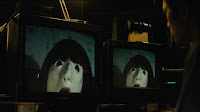Where does the mystery of analog media intersect with the danger of digital, besides the Twilight Zone? In this case, Chicago, a much scarier and more violent place. In 1987, broadcasts of a local sports report on WGN and an episode of Dr. Who really were interrupted by a person or persons who remain unknown to this day. It is the kind of conspiratorial lore that made great fodder for chatrooms in 1999, right at the cusp of the online revolution. A grieving video archivist goes down that rabbit-hole in Jacob Gentry’s Broadcast Signal Intrusion, which releases Tuesday on DVD and BluRay.
Years ago, James’ girlfriend disappeared in a presumed suicide, but her body was never recovered. He still carries guilt and lingering doubt that makes him receptive (or vulnerable) to the urban legends surrounding the broadcast signal intrusions. He comes across the first one while working on a temp project converting broadcast tapes to DVD. He soon learns the tape of the second incident was confiscated by the FCC and the FBI have a standing request for information on anyone who comes looking for it.
Instead of the Max Headroom mask aptly used in the real-life pirate intrusions, the videos James obsesses over feature a woman in a mask inspired by “Tara the Android.” The audio is drastically distorted, but the vibe suggests the woman is in a position of jeopardy. Digging deeper, James learns two Chicago women disappeared without a trace the day before each intrusion. His investigation really hits close to home when he uncovers rumors of a third interruption tape, recorded the day after his girlfriend vanished.
For the most part, BSI is a super-intriguing conspiracy thriller that wears its 1970s influences on its sleeve, while smartly integrating the early online culture and mindset. It sort of collapses in the last ten minutes, as conspiratorial thrillers almost always do, because they must decide to either reveal something (that is likely to be disappointing) or double-down on unknowable mystery, which is unsatisfying. Screenwriters Phil Drinkwater and Tim Woodall somehow manage to do both, but the weird trip they take viewers on to get to that point is still worth the price of admission.
The look and design of the film, from the dark video shelves of James’ work-station to the spot-on retro style of Don Cronos, the stand-in for Dr. Who, are perfect, in a suitably grungy way. Harry Shum Jr. is also terrific as the compulsively driven and emotionally damaged James (although his character is weirdly trusting at times). Chris Sullivan and Jennifer Jelsema also have standout scenes as “the Phreaker” (who may or may not be partially responsible) and Nora, a member of his suicide survivors’ support group. Steve Pringle and Madrid St. Angelo also add a lot of color and two of the people James significantly crosses paths with in his search for the truth.
There is a lot of cool peeling back of onion layers in BSI and the extent to which Drinkwater & Woodall keep it grounded in actual events makes it even eerier. Gentry maintains the appropriate atmosphere of paranoia and nicely builds suspense with the unsettling video images and suggestively garbled audio. There should be something in the film to rattle any member of a collegiate media studies department (and that is a good thing). Recommended for fans of conspiracy thrillers (with maybe a pinch of sf or horror), Broadcast Signal Intrusion releases Tuesday (12/7) on DVD.

